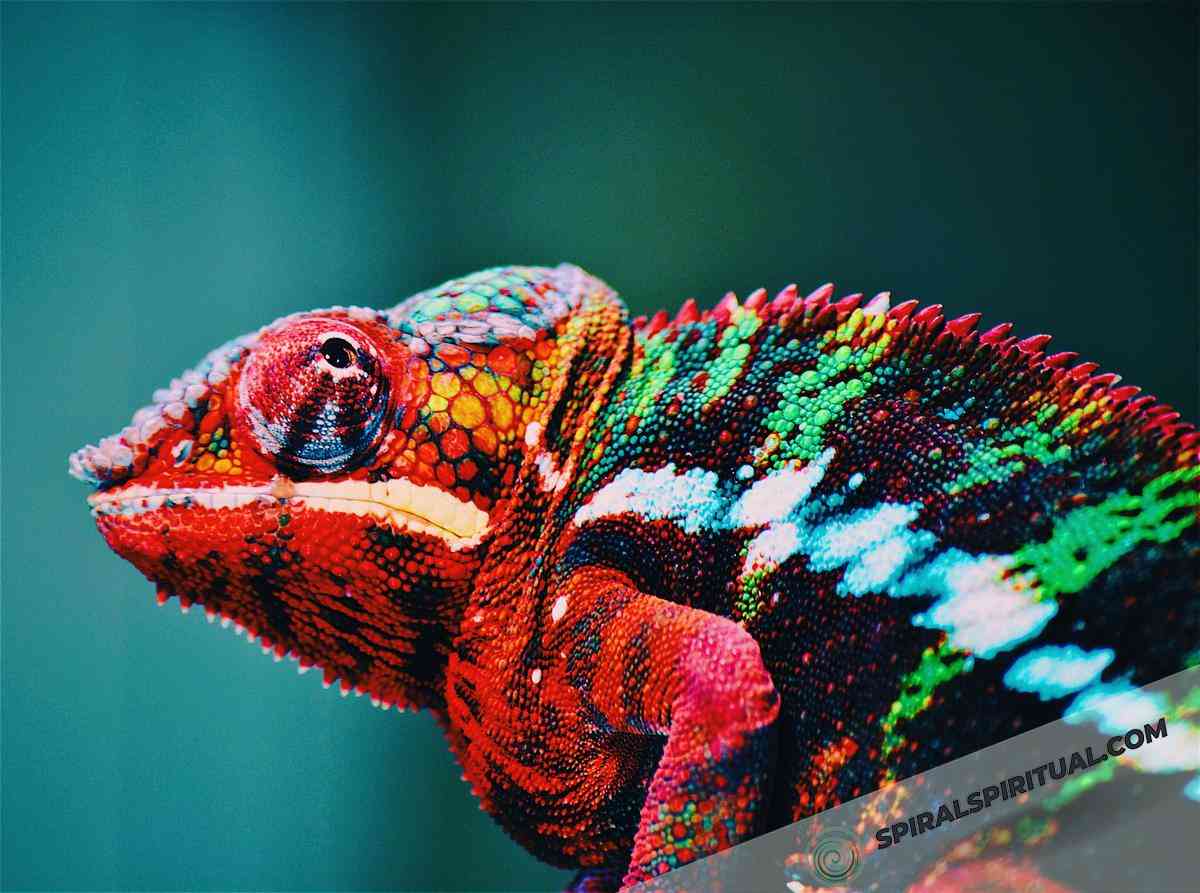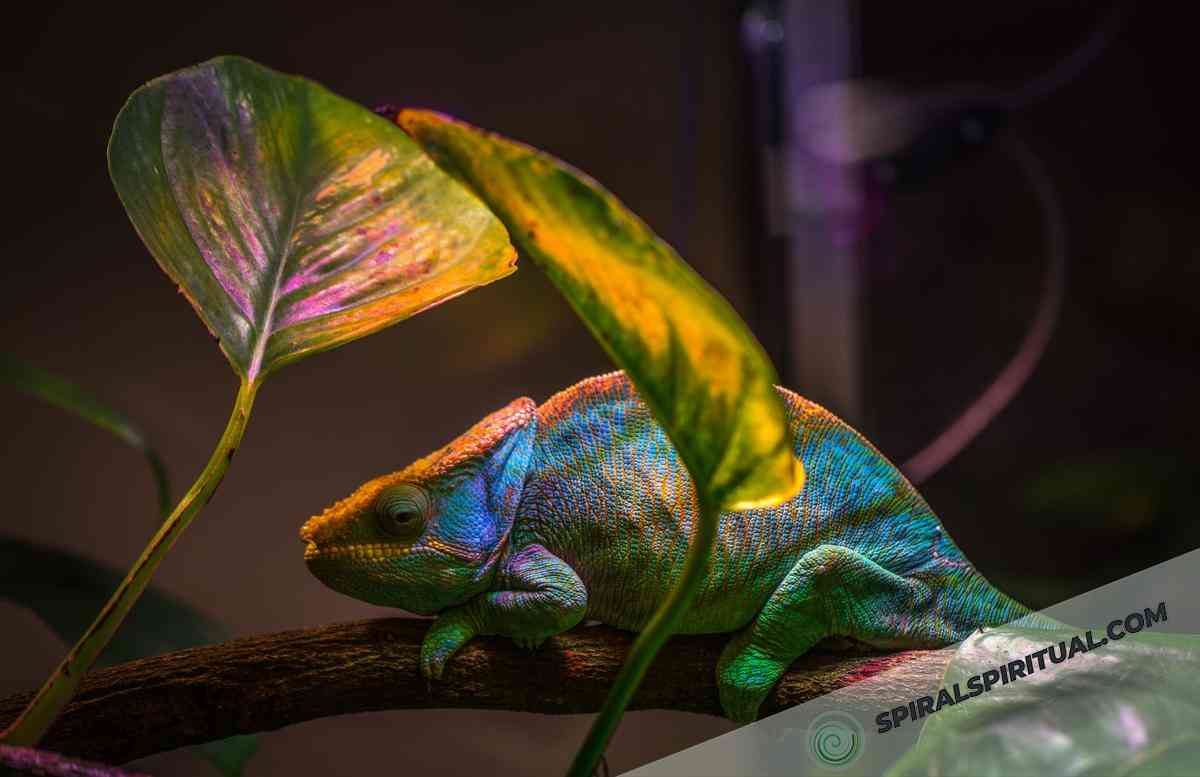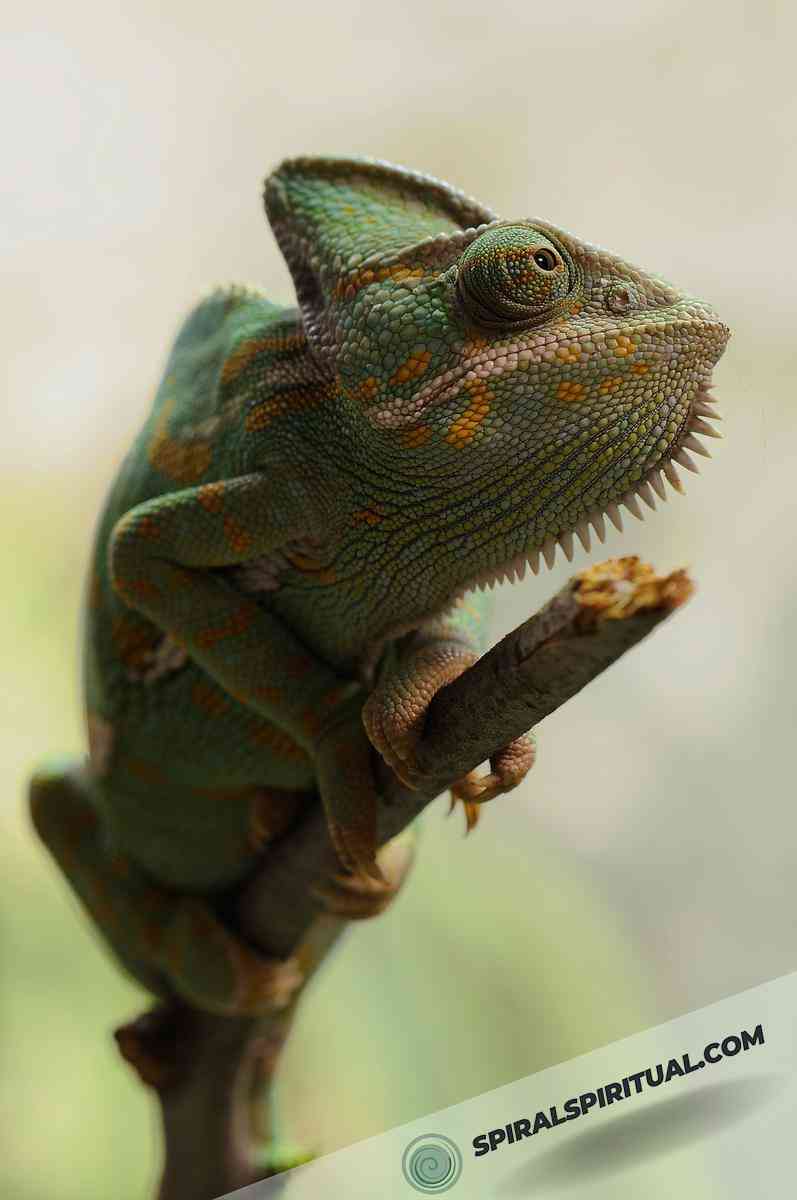Last Updated on February 2024
According to Jean Chevalier and Alain Gheerbrant’s “Dictionary of Symbols,” chameleons symbolize adaptability, transformation, and versatility. Their ability to change colors represents the capacity to blend in different environments. This spiritual meaning emphasizes the importance of flexibility and constant evolution in navigating life’s challenges.
5 Spiritual Meanings Behind the Chameleon
One day, my friend Sarah was feeling lost and unsure about her life path. As we sat by the lake, we saw a chameleon blending perfectly into its surroundings. We watched, mesmerized, as it changed colors, which seemed to symbolize adaptability and transformation.
In that moment, Sarah found comfort and inspiration. Like the chameleon shifting its hues, she realized she too could adapt, transform, and get through life’s challenges with strength and elegance. The chameleon gave her solace and reminded her of her inner power.
Chameleons hold various spiritual meanings that transcend cultural boundaries. These symbolic interpretations arise from their unique characteristics and behaviors. Here are five general spiritual meanings associated with chameleons:
- Adaptability and Flexibility: Chameleons possess unparalleled adaptability, adjusting their appearance to match their environment. In a spiritual context, this represents the importance of being flexible and open to change. It highlights the need to adapt to different situations and embrace new opportunities as they arise.
- Transformation and Growth: Just as chameleons can undergo a remarkable physical transformation by changing colors, they remind us of our own potential for personal growth and transformation. Their ability to shed old aspects of themselves symbolizes the shedding of outdated beliefs, habits, and limitations, enabling spiritual and emotional development.
- Observation and Awareness: Chameleons have highly observant nature, carefully scanning their surroundings before making any movement. Spiritually, this quality encourages individuals to cultivate mindfulness and deep awareness of their environment, allowing them to make conscious and informed choices. It symbolizes the importance of taking time to observe, reflect, and gain insights before taking action.
- Camouflage and Protection: Chameleons utilize their ability to camouflage as a defense mechanism, protecting themselves from potential threats. In a spiritual context, this suggests the significance of protecting one’s energy and maintaining boundaries. It signifies the need to shield oneself from negative influences and maintain authenticity amidst external pressures.
- Balance and Harmony: Chameleons’ ability to seamlessly blend with different surroundings reflects the pursuit of balance and harmony in life. They remind individuals of the importance of finding equilibrium between various aspects such as work and personal life, social and solitary pursuits, and physical and spiritual well-being. It serves as a reminder to maintain a harmonious existence both internally and externally.
The Symbolism of Chameleon in Different Cultures
The symbolism of the chameleon holds intriguing interpretations across various cultures. According to John C. Kricher’s authoritative work, “A Neotropical Companion,” African folklores attribute the chameleon with qualities of adaptability, transformation, and resilience, making it a symbol of protection and good fortune. In Native American traditions, the revered chameleon represents wisdom, harmonious connection with nature, and the power of keen observation.
Within Chinese culture, the chameleon assumes significance as a symbol of longevity and life-extension, as Lee Lai-Sheng elucidates in “Chinese Myths and Legends.” It is also associated with positive transformation and the capacity to adapt gracefully to ever-changing circumstances.
Moving to the realms of Mayan and Aztec civilizations, the chameleon’s symbolism embraces duality, reflecting both illusion and enlightenment. The Aztecs linked the chameleon’s color-changing ability with the transformative powers embodied by their deity Huitzilopochtli, as mentioned in “The Gods and Symbols of Ancient Mexico and the Maya” by Mary Miller and Karl Taube.
These cultural symbolisms emerge from rich oral traditions and ancient texts, embodying the deep-rooted beliefs and practices of respective societies. It is important to recognize the potential for regional variations and individual perspectives within these diverse cultural contexts.
Chameleon Color

| Color | Symbolic Meanings |
|---|---|
| Green | Green is one of the most commonly associated colors with chameleons. It is often linked to growth, renewal, and harmony with nature. The color green is seen as representing balance, abundance, and healing. It symbolizes the chameleon’s ability to adapt and blend into its environment seamlessly. |
| Brown | Brown is often associated with stability, earthiness, and grounding. It represents a connection with nature and the practical aspects of life. Brown may symbolize the chameleon’s ability to remain steady and steadfast in changing circumstances, reminding us to stay grounded and focused. |
| Yellow | Yellow is frequently linked to joy, happiness, and optimism. It symbolizes bright and positive energies, as well as intellectual growth and mental awakening. The color yellow may represent the chameleon’s ability to bring light and happiness into one’s life, reminding us to embrace positivity and strive for continual personal growth. |
| Blue | Blue is commonly associated with tranquility, peace, and emotional healing. It represents calmness and relaxation, bringing a sense of serenity. The color blue may symbolize the chameleon’s ability to adapt to its surroundings and evoke a feeling of peacefulness within oneself. |
| Red | Red is often associated with passion, vitality, and energy. It symbolizes strength, courage, and power. The color red may represent the chameleon’s ability to adapt and thrive in challenging situations, reminding us to embrace our inner strength and determination. |
| Purple | Purple is frequently linked to spirituality, intuition, and mysticism. It symbolizes wisdom, transformation, and enlightenment. The color purple may represent the chameleon’s ability to change and evolve, encouraging us to embrace personal growth and spiritual awakening. |
Is the Chameleon a Good Omen?
People often keep chameleons as pets because they think they bring good luck and positive energy. Chameleons are seen as spiritual animals that bring harmony, adaptability, and change. Their blending into surroundings represents agility and protection from negative energies.
Having a chameleon pet is believed to attract good fortune and ward off evil spirits. Their color changing also inspires creativity. Many find comfort and joy in having these mystical reptiles in their homes.
Chameleons symbolize positivity, good luck, harmony, and protection. That’s why people feel their presence brings blessings.
If They’re Appearing in Your Dreams
Dream experts say that seeing a chameleon in a dream is meaningful. A chameleon can change colors to blend into where it is. This symbolizes being able to adapt to different situations in life. It also stands for the need to grow personally and get through tough times.
Dream translator Laura Suzanne explains that a dream chameleon tells you to be flexible in how you live. It says to accept change without struggling. The chameleon encourages people to keep an open mind for new experiences. And it reminds them that they can adjust to different circumstances.
If You See a Dead Chameleon

If you see a dead chameleon in a dream, it can mean the end of a life phase. Or that you’ve lost the ability to adapt in a situation you’re in. The dead chameleon shows a lack of flexibility. Or that you can’t adjust to changes happening in your life.
Dream translator Pamela Cummins says a dead dream chameleon means “you can no longer blend in or get used to something.” It might mean you feel stuck or unable to handle a tough problem. This could be a sign to rethink your approach. And to find new ways to be open to change and adapt.
Final Thoughts
Chameleons have different symbolic meanings across cultures and beliefs. Their color changing shows adaptability. Specific colors also have meaning. Chameleons in dreams mean you should be flexible and grow as a person.
The article talked about:
- What chameleons represent in different cultures
- The meaning of different chameleon colors
- What it means when chameleons are in dreams
Chameleons, as pets, cultural symbols, or in dreams remind us: embrace change, stay harmonious with our surroundings, and tackle life’s problems with an open, resilient mindset.
References
Here is the literature that was used for writing this article:
- “Animal-Speak: The Spiritual & Magical Powers of Creatures Great & Small” by Ted Andrews, Llewellyn Publications, Ted Andrews.
- “The Encyclopedia of Symbols” by Carl G. Liungman, W. W. Norton & Company, Carl G. Liungman.
- “Animal Spirit Guides: An Easy-to-Use Handbook for Identifying and Understanding Your Power Animals and Animal Spirit Helpers” by Steven D. Farmer, Hay House, Steven D. Farmer.
- “The Chameleon’s Dish: Metaphor, Parables, and Tales That Reflect and Illuminate the Christian Life” by Edmunds, Roger. Parables, Roger Edmunds.








